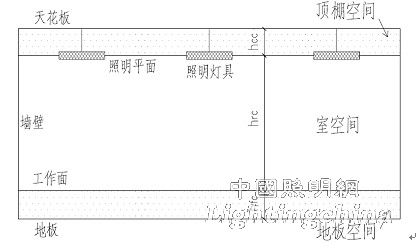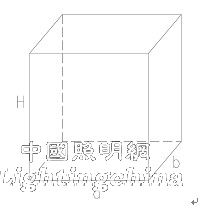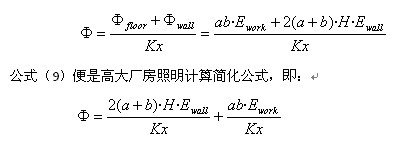1 Industrial building and tall factory lighting design features Activities in buildings in industrial fields are usually carried out around the processing and production of products, centered on production and workers' activities. The lighting design of industrial buildings should ensure safe, efficient and uninterrupted industrial production activities, ensure high labor efficiency, reduce production errors and scrap rates, save energy and reduce production costs. The tall building is a type of building for industrial buildings, such as the hull workshop of the shipyard, the aircraft assembly workshop of the aircraft manufacturer, etc. Usually the building height is relatively large, generally higher than 10 meters, and some can reach 50 meters or even 80 meters. . Based on the corresponding characteristics, in the lighting calculation process, the total luminous flux of the luminaire that meets the lighting requirements is directly obtained through the height of the building layer, thereby helping to simplify the lighting calculation. 2 Derivation of simplified formula for lighting calculation of tall buildings 2.1 Using the coefficient method to calculate the lighting method of tall factory buildings The use of the coefficient of calculation method to calculate the illumination data is one of the most commonly used methods for calculating the illumination level in architectural electrical lighting design. Using the coefficient of calculation method to calculate the illumination data, the key is to reflect the utilization of the luminous flux on the working surface to the luminous flux of the lamps in the building space. Using the utilization factor method, the room needs to be divided into three spaces, from top to bottom, the ceiling space, the room space and the floor space [1], as shown in Figure 1. Figure 1. Division of room space In addition to being used by the work surface, the luminous flux of the luminaire in the room is also used by the ceiling and the wall. Therefore, the corresponding relationship between the working surface and the ceiling and the wall can be found to obtain the utilization of the luminous flux on the working surface. High-rise buildings usually have the characteristics of high floor height and large area, and because of the ventilation requirements of the plant, there are fewer walls for illumination reflection. In general, the ratio of the height of the ceiling space of the tall building and the height of the floor space to the height of the room space is very large, that is, the sum is large, usually greater than 10, so when using the coefficient method for high-rise lighting design, both Can be ignored to make the necessary estimates. Illumination on the ceiling is not very helpful for production activities and is part of the need for savings. Controlling the light distribution curve of the luminaire can generally reduce the luminous flux of the luminaire for the ceiling. Therefore, in this study we assume that the ceiling illumination is zero, that is, all the luminous flux contributed by the luminaire is projected on the wall and the work surface. 2.2 High-rise plant lighting calculation simplified formula derivation Create a typical room-shaped space for easy lighting design discussions. Assume that the building space of a tall building is a, the width is b, and the height is H, as shown in Figure 2. Figure 2. Schematic diagram of the space inside the tall building Assuming that the total floor area is Sfloor and the total area of ​​all walls is Swall, the total area S of the luminous flux of the luminaire is: Ignore the floor space with a height of less than 1 meter, so the working surface illumination level Ework can be regarded as equal to the floor illumination level Efloor, ie: If the total illuminance of the luminaire in the tall building is Φ, the maintenance factor is Kx; the luminous flux obtained by the luminaire on the working surface (the same floor surface) is Φfloor, and the luminous flux obtained by the luminaire on the wall is Φwall, then: then: Generally, the working surface illumination Ework has corresponding illumination requirements in the current lighting specification GB 50034-2004 "Architectural Lighting Design Specification" [2], so Ework can be considered as a fixed value. For tall buildings with different floor heights, the lighting design generally selects the lamps with different light distribution curves. By controlling the light distribution curve of the selected lamps, the average illumination of the walls can be equal. That is, the tall building in a certain height range, after the lighting design, the illuminance level Ewall obtained by the wall is equal. In formula (10), for tall buildings with different area and height, the building space length a, width b, working surface illuminance Ework, and wall illuminance Ewall are fixed values. The maintenance factor Kx of the same type of tall building should also be the same, and the height. H is the amount of change, then you can continue to write: Both are fixed and both are positive, so equation (11) is a linear function between Φ and H. Therefore, it can be concluded that for tall buildings with a certain area, the same use, and different heights, the higher the height, the greater the total luminous flux of the lamps required for lighting design. 3 Summary of calculation methods In the lighting design of tall buildings, the simplified calculation formula (10) makes it easy to calculate the lighting. Using formula (10) for high-rise plant lighting design, the corresponding lighting parameters need to be determined for the design object, and the corresponding parameters can be obtained by substituting the corresponding parameters into formula (10). Finally, according to the characteristics of the lighting design object to choose the type and number of lamps, you can complete the lighting design, the steps are as follows: (1) Determining the chamber space For a typical tall building, using the simplified calculation formula (10), it is first necessary to determine its chamber space and analyze the building space length a, width b and height H. (2) Determine the lighting data of tall buildings Analysis of the building type of tall buildings, you can get the maintenance factor Kx and illuminance level Ework through the "Architectural Lighting Design Code". In addition, through the analysis of similar success stories, the wall illumination Ewall of the same type of tall buildings is generally equal, so Ewall can be calculated using empirical values. (3) Calculate the total luminous flux of the luminaire Using the determined data, building space length a, width b, height H, maintenance factor Kx, working surface illumination Ework and wall illumination Ewall, substituting a simplified calculation formula (10) for tall factory lighting design, you can get the lamps used in tall buildings. Total luminous flux Φ. (4) Determine the type of fixture and complete the lighting design The architectural styles of different heights use different light distribution curves of the lamps, and this principle should also be followed in the lighting design of tall buildings. To select the appropriate light distribution curve for the height of the design object, you need to pay attention to the corresponding data of the luminaire sample. In general, wide beam luminaires are used at lower heights and luminaires with narrow beam grading at higher altitudes. By dividing the total luminous flux Φ of the luminaire by the single-light flux of the selected luminaire, the number n of selected luminaires is obtained, ie: Reasonably arranging the calculated number of luminaires within the building space can meet the illuminance requirements specified in the specification. 4 Conclusion Accurate illumination data can be obtained by using the coefficient method for illuminance calculation, but requires a large amount of data and a cumbersome calculation process. Therefore, in the lighting design of building electrical, the utilization coefficient method is not often used, and the designers generally estimate based on experience. The error in this estimate is usually larger. The simplified calculation method proposed in this paper is applied in tall buildings, ignoring the influence of some data, so there will be certain errors, but this error is basically offset by the architectural characteristics of tall buildings. Since the engineering field allows errors and errors are inevitable, this simplified calculation method is of practical value in engineering practice. Power Plant Transformer,Auto Power Transformer,Auto Transformer,High Quality Auto Power Transformer Hangzhou Qiantang River Electric Group Co., Ltd.(QRE) , https://www.qretransformer.com






